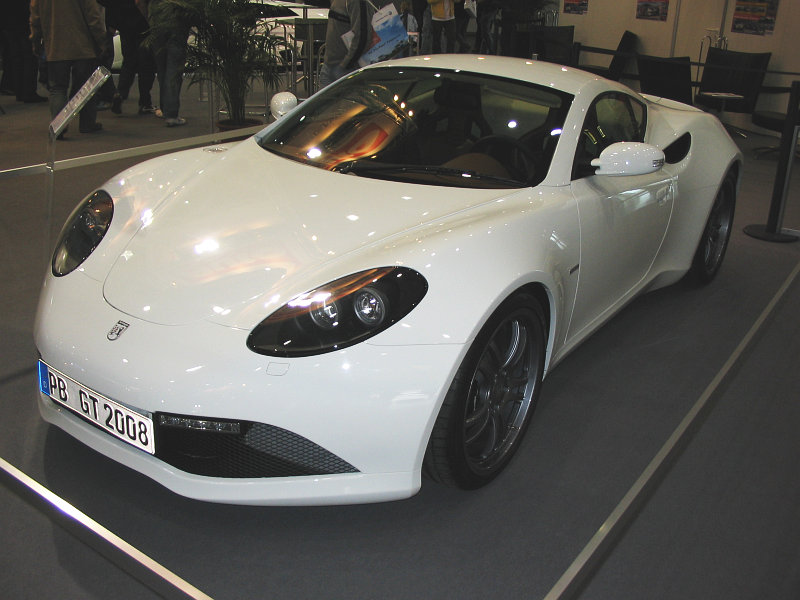In the realm of high-performance sports cars, some stories remain untold — hidden gems that deserve their moment in the spotlight. The Artega GT represents one such masterpiece, born from the collaboration between former Porsche engineer Hardy Essig and renowned designer Henrik Fisker. This German sports car emerged as a testament to precision engineering and innovative design thinking.
When the Artega GT made its debut at the 2007 Geneva Motor Show, it didn’t just introduce another sports car — it revealed a new philosophy in automotive design. The fusion of German engineering precision with Italian-inspired aesthetics created something truly unique in the automotive landscape.
Engineering Excellence Unleashed
The heart of the Artega GT beats with remarkable intensity — a Volkswagen-sourced 3.6-liter V6 engine that produces an impressive 300 horsepower. This powerplant, carefully tuned to deliver 350 Nm of torque at 2400 RPM, transforms the GT into a remarkably responsive machine. The engine’s placement and configuration reflect years of performance car development experience.
Dr. Marcus Weber, former powertrain development specialist, shares his perspective: «The Artega GT’s engine calibration represents a masterclass in power delivery. The way they’ve tuned the V6 creates a perfect balance between everyday usability and track-day performance. It’s rare to find this level of refinement in a limited-production sports car.»
The engineering team’s attention to detail extends beyond raw power. The integration of a six-speed DSG transmission with dual-clutch technology showcases their commitment to performance. This drivetrain configuration ensures lightning-fast gear changes while maintaining the smooth operation expected in a premium sports car.
Fact!
The Artega GT's engine is actually a more powerful version of the VR6 engine found in the Volkswagen CC, but with significant modifications to enhance performance and response.
Design & Construction: Where Form Meets Function
The Artega GT’s aluminum body structure represents a triumph in lightweight engineering. Every panel, every curve serves both aesthetic and functional purposes. The car’s design language speaks of purposeful minimalism — clean lines that cut through the air efficiently while creating a timeless silhouette.
Materials specialist Dr. Sarah Chen observes: «The use of aluminum in the Artega GT’s construction wasn’t just about weight reduction. The engineering team created a structure that optimizes rigidity while maintaining the kind of repairability that’s often overlooked in exotic car design.»
The following elements define the GT’s construction philosophy:
- aerospace-grade aluminum alloys selected for optimal strength-to-weight ratio;
- strategic reinforcement points to enhance torsional rigidity;
- modular design approach allowing for efficient assembly and maintenance;
- aerodynamically optimized body panels reducing drag while increasing stability.
Important!
The Artega GT's body structure achieved an impressive balance of lightweight construction and structural integrity, weighing significantly less than competitors while maintaining exceptional safety standards.
Performance That Speaks Volumes
The Artega GT’s performance credentials read like a wish list for sports car enthusiasts. With a top speed exceeding 257 km/h and acceleration that pins you to the seat, this machine delivers supercar-level performance in a more compact package.
Professional driver Michael Kraft shares his track experience: «The Artega GT shows its true character on the circuit. The direct steering response and balanced chassis create a level of driver engagement that rivals much more expensive sports cars. It’s a precision instrument that rewards skillful driving.»
The car’s handling characteristics stem from its perfectly balanced chassis and sophisticated suspension setup. The combination of lightweight construction and optimized weight distribution creates a vehicle that responds intuitively to driver inputs.
A Legacy of Innovation
While the Artega GT’s production run was limited, its influence on sports car design continues to resonate. The car’s approach to lightweight construction and aerodynamic efficiency set new standards for what could be achieved in a boutique sports car manufacturer.
Here’s what makes the Artega GT a true collector’s item:
- limited production numbers ensuring exclusivity;
- innovative engineering solutions that influenced future sports car design;
- combination of German engineering and Italian design aesthetics;
- remarkable performance capabilities that still impress today.
Each example represents a piece of automotive history — a moment when a small German company dared to challenge the established sports car hierarchy.
Beyond the Horizon
Looking back at the Artega GT today reveals more than just a remarkable sports car. It stands as proof that innovation in automotive design doesn’t always come from industry giants. The GT’s legacy lives on in the way it approached the challenges of creating a modern sports car.
The story of the Artega GT reminds us that true innovation often comes from those willing to think differently. While production numbers remained limited, each car represents a bold vision of what a sports car could be.
Pros and Cons
| Advantages | Disadvantages |
|---|---|
| Exceptional power-to-weight ratio thanks to aluminum construction | Limited production run affecting parts availability |
| Advanced VW-sourced V6 engine providing reliable performance | Relatively unknown brand compared to established manufacturers |
| Sophisticated dual-clutch transmission ensuring quick shifts | Limited dealer network and service options |
| Outstanding handling characteristics and driver feedback | Higher maintenance costs due to specialty parts |
| Unique design by Henrik Fisker creating timeless aesthetics | Challenging resale market due to brand obscurity |
| Excellent build quality and material selection | Limited aftermarket support |
The Artega GT represents a fascinating chapter in sports car history. While it may not have achieved widespread commercial success, it succeeded in creating something truly special — a driver’s car that combined German engineering precision with Italian design flair. Its legacy serves as a reminder that sometimes the most interesting automotive stories come from unexpected places.

